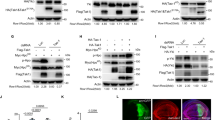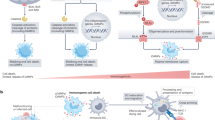Abstract
Intracellular Rho GTPases provide an important regulatory mechanism to connect cell-surface-generated signals with the nucleus. By cycling between the active (guanosine 5′-triphosphate [GTP]) and inactive (guanosine 5′-diphosphate) state, these GTP-binding proteins control cellular functions ranging from dynamic actin remodeling and activation of transcription factors to cell-cycle progression and cellular transformation. Their contribution to these very diverse processes makes them an essential part of cell movement, growth, and apoptosis. Upstream regulatory mechanisms, as well as a variety of downstream effector molecules, enable Rho GTPases to act in a specific, orchestrated manner, dictating cellular responses. In this article, I review my laboratory's work centering on the goal of determining how specificity in intracellular signaling is achieved and identifying molecular mechanisms of Rho GTPase-mediated processes in innate immune and transformed cells.
Similar content being viewed by others
References
Van Aelst L, D'Souza-Schorey C: Rho GTPases and signaling networks. Genes Dev 1997;11:2295–2322.
Mackay DJG, Hall A: Rho GTPases. J Biol Chem 1998;273:20,685–20,688.
Hall A: Rho GTPases and the actin cytoskeleton. Science 1998;279:509–514.
Del Peso L, Hernandez-Alcoceba R, Embade N: Rho proteins induce metastatic properties in vivo. Oncogene 1997;15(25):3047–3057.
Qiu RQ, Chen J, Kirn D, McCormick F, Symons M: An essential role for Rac in Ras transformation. Nature 1995;374:457–459.
Manser E, Leung T, Salihuddin H, Zhao Z-S, Lim L: A brainserine/threonine protein kinase activated by Cdc42 and Rac1. Nature 1994;367:40–46.
Knaus UG, Bokoch GM: The p21RacCdc42-activated kinases (PAKs). Int J Biochem Cell Biol 1998;30:857–862.
Bokoch GM, Wang Y, Bohl B, Sells MA, Quilliam LA, Knaus UG: Interaction of the Nck adapterprotein with p21-activated kinase (PAKI). J Biol Chem 1996;271:25,746–25,749.
Manser E, Loo TH, Koh CG, et al.: Embaden N: PAK kinases are directly coupled to the PIX family of nucleotide exchange factors. Mol Cell 1998;1:183–192.
Zhang S, Han J, Sells MA, Chernoff J, Knaus UG, Ulevitch RJ, Bokoch GM: Rho Family GTPases regulate p38-mitogen-activated protein kinase through the downstream mediator Pak1. J Biol Chem 1995;270:23,934–23,936.
Rudel T, Bokoch GM: Membrane and morphological changes in apoptotic cells regulated by caspase-mediated activation of Pak2. Science 1997;276:1571–1574.
Tjandra H, Compton J, Kellogg D: Control of mitotic events by the Cdc42 GTPase, the C1b2 cyclin and a member of the PAK kinase family. Curr Biol 1998;8(18):991–1000.
Sells MA, Knaus UG, Bagrodia S, Ambrose DM, Bokoch GM, Chernoff J: Human p21-activated kinase (Pak1) regulates actin organization in mammalian cells. Curr Biol 1997;7:202–210.
Finkel T: Oxygen radicals and signaling. Curr Opin Cell Biol 1998;10:248–253.
Babior BM: NADPH oxidase: an update. Blood 1999;5:1464–1476
Knaus UG, Heyworth PG, Evans T, Curnutte JT, Bokoch GM: Regulation of phagocyte oxygen radical production by the GTP-binding protein Rac2. Science 1991;254:1512–1515.
Heyworth P, Knaus UG, Xu X, Uhlinger D, Conroy L, Bokoch GM, Curnutte J: Requirement for post-translational processing of RacGTP-binding proteins for activation of human neutrophil NADPH oxidase. Mol Biol Cell 1993;4:261–269.
Knaus UG, Morris S, Dong H-J, Chernoff J, Bokoch GM: Regulation of human leukocyte p21-activated kinases through G protein-coupled receptors. Science 1995;269:221–223.
Ago T, Nunoi H, Ito T, Sumimoto H: Mechanism for phosphorylation-induced activation of the phagocyte NADPH oxidase protein p47prox J Biol Chem 1999;274:33,644–33,653.
Bernard V, Bohl BP, Bokoch GM: Characterization of Rac and Cdc42 activation in chemoattractant-stimulated human neutrophils using a novel assay for active GTPases. J Biol Chem 1999;274:13,198–13,204.
Szatrowski TP, Nathan CF: Production of large amounts of hydrogen peroxide by human tumor cells. Cancer Res 1991;51:794–798.
Suzuki YJ, Forman HJ, Sevanian A: Oxidants as stimulators of signal transduction. Free Radical Biol Med 1997;22:269–285.
Suh Y-S, Arnold RS, Lassegue B, Shi J, Xu X, Sorescu D, Chung AB, Griendling KK, Lambeth JD: Cell transformation by the superoxide-generating oxidase Mox1. Nature 1999;401:79–82.
Sundaresan M, Yu Z-X, Ferrans VJ, Sulciner DJ, Gutkind JS, Irani K, Goldschmidt-Clermont PJ, Finkel T: Regulation of reactive oxygen species generation in fibroblasts by Rac 1. Biochem J 1996;318:379–382.
Kheradmand F, Werner E, Tremble P, Symons M, Werb Z: Role of Rac1 and oxygen radicals in collagenase-1 expression induced by cell shape changes. Science 1998;280:898–902.
Michiels F, Habets GGM, Stam JC, Van der Kammen RA, Collard JG: A role for Rac in Tiam1-induced membrane ruffling and invasion. Nature 1995;375:338–340.
Roberts AW, Kim C, Zhen JB, et al: Deficiency of the hematopoietic cell-specific Rho family GTPase Rac2 is characterized by abnormalities in neutrophil function and host defense. Immunity 1999;10(2):183–196.
Mira J-P, Benard V, Groffen J, Sanders LC, Knaus UG: Endogenous, hyperactive Rac3 controls proliferation of breast cancer cells by a p21-activated kinase-dependent pathway. Proc Natl Acad Sci USA 2000;97(1):185–189.
Haataja L, Groffen J, Heisterkamp N: Characterization of Rac3, a novel member of the Rho family. J Biol Chem 1997;272:20,384–20,388.
Zohn IM, Campbell SL, Khosrave-Far R Rossman KL, Der CH: Rho family proteins and Ras transformation: the RHOad less traveled gets congested. Oncogene 1998;17:1415–1438.
King AJ, Sun H, Diaz B, Barnard D, Miao W, Bagrodia S, Marshall MS: The protein kinase Pak3 positively regulates Raf-1 activity through phosphorylation of serine 338. Nature 1998;396:180–183.
Frost JA, Steen H, Shapiro P, Lewis T, Ahn N, Shaw PE, Cobb MH: Cross-cascade activation of ERKs and ternary complex factors by Rho family proteins. EMBO J 1997;16:6426–6438.
Tang Y, Yu J, Field J: Signals from the Ras, Rac, and Rho GTPases
Author information
Authors and Affiliations
Rights and permissions
About this article
Cite this article
Knaus, U.G. Rho GTPase signaling in inflammation and transformation. Immunol Res 21, 103–109 (2000). https://doi.org/10.1385/IR:21:2-3:103
Issue Date:
DOI: https://doi.org/10.1385/IR:21:2-3:103




